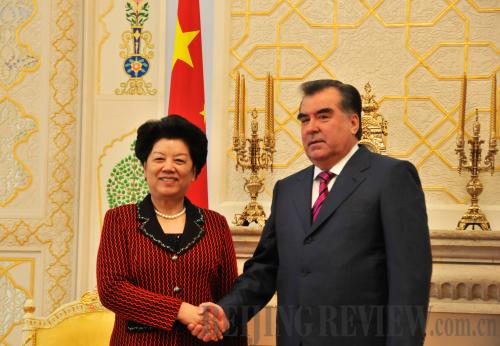|
 |
|
CELEBRATING FRIENDSHIP: Tajik President Emomalii Rahmon meets Chinese President Hu Jintao's special envoy Chen Zhili, Vice Chairwoman of the Standing Committee of the National People's Congress of China, in Dushanbe, on January 12, who recently visited Tajikistan and the other four Central Asian nations (SUN WENBIN) |
Moreover, the two countries have engaged in fruitful security cooperation. Mutual exchanges in national defense and public security are frequent. Cooperation in personnel training, intelligence sharing, technological and material assistance, antiterrorism, and the fight against organized crime, drug smuggling and human trafficking is close.
In which aspects can we say the economy and trade of the two countries are highly complementary? As one of the important overseas investment destinations for Chinese enterprises, which fields of Tajikistan are Chinese enterprises interested in?
Economic and trade links between the two countries have grown rapidly over the years.
Their trade volume increased from $2.75 million in 1992 to nearly $1.5 billion in 2010. The trade volume in the first three quarters of 2011 reached $1.47 billion. In the last five years, bilateral trade volume has increased 15 times and the two sides have cooperated in more than 50 large- and medium-sized projects.
Of the $900 million preferential export buyer's credit that China provided to other SCO members, Tajikistan received more than two thirds. The country spent the money on the Sino-Tajik Friendship Tunnel, the Tajikistan-Uzbekistan highway and two important power transmission lines. The China Road and Bridge Corp. (CRBC) and the Tebian Electric Apparatus Stock Co. Ltd. were contracted to construct these projects.
Apart from the Tajikistan-Uzbekistan highway, Chinese companies have also built the Tajikistan- Kyrgyzstan highway and are building the China-Tajikistan highway. In 2011 when Tajikistan celebrated the 20th anniversary of its independence, the CRBC completed the restoration of Dushanbe's Rudaki Avenue on schedule. In recent years, Chinese construction companies have undertaken more and more large projects in Tajikistan including the country's national library, national museum and Foreign Ministry complex.
Tajikistan is rich in mineral resources. There is great potential for cooperation in this field between the two countries. The number of Chinese mineral resource exploitation companies working in Tajikistan and the amount of their investment have been on the rise over the last two decades. The gold exploitation project and lead-zinc exploitation project of Zijin Mining Group and Xinjiang Tacheng International Resources Co. Ltd. are very successful, and have become the models for cooperation. Presently, the two Chinese miners have become large taxpayers of the Tajik Government.
Agricultural cooperation between China and Tajikistan has also made headway in recent years. Many enterprises from Xinjiang have come to Tajikistan to contract plots of land for development. They employ advanced farming technologies as well as high-quality seeds to grow rice and cotton and have made good profits. In the next stage, the two sides will further cooperate on agricultural machinery, seed cultivation and staff training.
China is also an important partner of Tajikistan's telecom industry. China's two telecom equipment giants Huawei and ZTE have established good partnerships with local telecom operators, and have become major equipment and service providers of Tajikistan's telecom industry.
Tajik people share the time-honored Pamir culture with people in China's Xinjiang Uygur Autonomous Region. In recent years, how have the cultural and economic exchanges between Tajikistan and Xinjiang grown?
The Xinjiang Uygur Autonomous Region is a bridgehead for pragmatic cooperation between the two countries. In recent years, the trade volume between Xinjiang and Tajikistan accounted for 72 percent of the total Sino-Tajik trade volume. Cooperation between Xinjiang and Tajikistan is fruitful and progressing in every field.
In August 2011, Zhang Chunxian, Secretary of the Xinjiang Autonomous Regional Committee of the Communist Party of China, headed a trade delegation to Tajikistan and met with President Rahmon. The two sides exchanged ideas for in-depth cooperation. In addition, trade at the Sino-Tajik Karasu-Kulma border crossing is flourishing. Trade deals here account for 14 percent of the two countries' total trade volume.
Of the five Chinese art groups that visited Tajikistan in 2011, three were from Xinjiang. In the same year, Tajik art groups also participated in the Xinjiang International Folk Dance Festival in June and the Xinjiang International Children's Art Festival in August.
Email us at: yulintao@bjreview.com | 